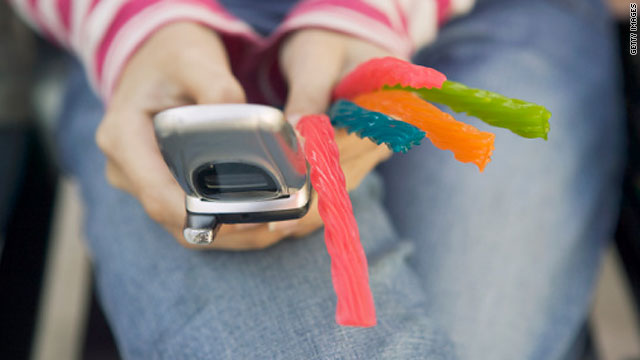
(CNN) -- Nearly one-sixth of teens who own cell phones have received nude or nearly nude images via text message from someone they know, according to a new survey on "sexting" from the Pew Internet & American Life Project.
The national telephone survey confirms parent and teacher worries that young people are using cell phones to send out and receive sexually explicit images of themselves and of romantic partners.
The 800-person survey, released Tuesday by the nonprofit research group, found 15 percent of cell-phone-owning teens ages 12 to 17 had received nude or nearly nude photos by phone. Four percent of the teens said they had sent out sexually explicit photos or videos of themselves.
Older teens were more likely to send sexual images through text messages than younger teens. Four percent of 12-year-olds reported sending sexually suggestive images by text message, while 8 percent of 17-year-olds reported texting nude or partially nude photos.
The Pew survey suggests teens who pay their own cell phone bills and who have unlimited text messaging plans are more likely to engage in sexting than those who use phones owned by their parents or have restrictions placed on how frequently they can text.
However, teens whose parents searched through their cell phones were no more or less likely to send and receive sexually explicit text messages than those whose phones were kept private, the report says.
Boys and girls surveyed were equally likely to say they engage in sexting.
The survey results were paired with focus-group interviews of 74 teens in three cities to create Tuesday's report, titled "Teens and Sexting." The report is not the first to try to quantify teenage sexting, a practice that is still so new and little understood that it's difficult to say if it is on the rise or decline among teens.
Teenage sexting usually is done as part of a relationship or would-be relationship between teens, the Pew focus groups found.
Some teens send sexts only to people with whom they are in a relationship; but those messages often are forwarded to people outside the relationship, especially after a breakup, according to the interviews.
"It doesn't take that many people creating these images for a lot of people to see them," said Amanda Lenhart, a senior research specialist at the Pew Internet & American Life Project and author of the sexting report.
Lenhart said the focus groups highlighted the fact that teens look at sexting in a range of ways. Some teens interviewed by Pew said sexting was no cause for concern.
"I only do it [sexting] with my girlfriend b/c we have already been sexually active with each other. It's not really a big deal," one high school boy wrote in a Pew focus group.
Others said sexting is part of teenage culture -- partly because it can be more convenient or less intimidating than traditional dating.
"Most people are too shy to have sex," another high school boy told Pew. "Sexting is not as bad."
Still others quoted in the report acknowledge the dangers of sexting -- including the fact that recipients of naked pictures can easily forward them to friends or post them on the Internet to fuel a grudge.
"This girl sent pictures to her boyfriend. Then they broke up and he sent them to his friend, who sent them to like everyone in my school. ... It ruined high school for her," one older high school boy wrote in the survey.
Bill Albert, spokesman for the National Campaign to Prevent Teen and Unplanned Pregnancy, said it's that fine line between private and public that's least understood, but should be of the most concern for teens and their parents.
"Things go from private to global in a nanosecond in this world," he said.
Albert's group published a survey in 2008 that found 20 percent of teens age 13 to 19 said they had texted or posted online sexy photos or videos of themselves.
The number of kids who are sexting should concern parents enough to make them talk to their kids about the dangers of sexting, but should not cause them to panic, he said. Any behavior, including sexting, that contributes to a culture of casual sexual encounters should be of concern to parents, he said.
He urged parents not to blame cell phones for the trend.
"To me, blaming the technology is like blaming an automobile for drunk driving," he said. "It is not the product, it is not the technology that is the problem. It is the judgment of the people using the technology."
The prevalence of sexting coincides with greater cell phone use among teens in general. In a 2004 Pew Internet survey, 18 percent of 12-year-olds said they owned a cell phone; in a 2009 follow-up, 58 percent of kids age 12 reported having their own mobile device.
The Pew report on sexting also underscores the complicated legal climate surrounding teenage sexting.
Teens in some states, like Florida and Pennsylvania, have been prosecuted or threatened with prosecution on child pornography laws because they sent out nude images through text messages, the Pew report says. Ohio is considering legislation to criminalize sexting between minors; Vermont and Utah have downgraded penalties for first-time sexters, the report says.
Parents should concentrate on making their kids aware of the potential legal and emotional ramifications of sexting, Albert said.
Avery Murphy, an 18-year-old member of the National Campaign to Prevent Teen and Unplanned Pregnancy's youth leadership group, said the increasing popularity of phones with cameras seems to be behind the sexting trend as much as anything.
She suggested parents talk to their teens about appropriate cell phone use when their kids first get cell phones. But don't overdo it, she said, because teens generally understand the dangers of sexting.
"Parents think it's happening more than it actually is," she said. "It's not seen as very normal by teenagers."








No comments:
Post a Comment